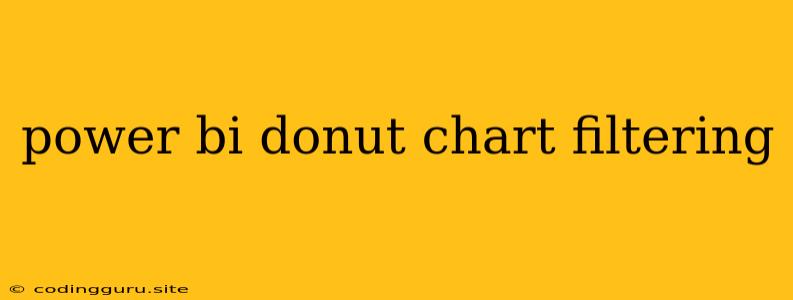Power BI Donut Chart Filtering: Enhancing Your Data Visualization
Donut charts, a variant of pie charts, are a popular choice for visualizing data proportions. But what if you want to filter your donut chart to focus on specific segments of data? Power BI provides several powerful techniques to achieve this, allowing you to create interactive and insightful visualizations.
How Can I Filter My Donut Chart in Power BI?
Power BI offers a multitude of ways to filter your Power BI donut chart. Here's a breakdown of the most common methods:
1. Slicers: Slicers are interactive controls that let you filter data based on different categories. Simply drag a field you want to use for filtering into the Slicers pane in the Visualizations area. You can use multiple slicers simultaneously to create complex filtering scenarios.
2. Filters Pane: The Filters pane provides granular control over the data displayed in your Power BI donut chart. You can apply filters based on individual fields, use logical operators like "AND" and "OR", and even create custom formulas to tailor your filtering logic.
3. Drill-Through: For exploring deeper insights, you can use Drill-Through. This functionality allows you to navigate from a segment in your donut chart to a separate visualization that provides more detailed information about the selected segment.
4. Cross-Filtering: Power BI donut chart can interact with other visualizations on your report page. By applying filters to a connected chart, you can automatically filter your donut chart to display only the relevant data.
Tips for Effective Power BI Donut Chart Filtering
- Choose relevant fields: Selecting the right fields for filtering is crucial. Consider what insights you want to highlight and choose fields that provide clear segmentation.
- Use clear labels: Ensure your donut chart segments have clear and concise labels to aid comprehension and guide user interactions.
- Experiment with colors and formatting: Use color palettes and formatting techniques to visually distinguish between filtered and unfiltered segments.
- Use drill-down for deeper insights: If you need more detailed information about specific segments, consider incorporating drill-through to explore related data.
Example Scenario: Filtering Sales by Product Category
Imagine you're analyzing sales data for a retail store. You want to create a Power BI donut chart showing the proportion of sales for each product category. To filter this donut chart by specific categories, you can use a slicer based on the Product Category field. When you select a specific category from the slicer, the donut chart will update to display only the sales for that chosen category.
Conclusion
Power BI offers a flexible and intuitive approach to filtering Power BI donut charts. By leveraging slicers, filters, drill-through, and cross-filtering, you can create dynamic and interactive visualizations that cater to your specific analysis needs. Experiment with different techniques to find the best combination for your data and reporting goals. Remember to keep your audience in mind and aim for clarity, engagement, and effective communication of insights.
